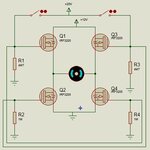Follow along with the video below to see how to install our site as a web app on your home screen.
Note: This feature may not be available in some browsers.
How do you guys read the tiny text on the fuzzy JPG image? On the other website I said it is because the schematic has its parts too far apart but I did not mention increasing the size of the schematic to see it covered with JPG fuzz.

Hi,
Your picture shows just two "messages", no warning, no error.
You don't show what is not like expected.
Still the drving circuit / driving voltages are not correct.
--> simply measure V_GS (voltage between gate and source) of each Mosfet in ON and OFF condition.
Your junction dots are weird. Some are correct, some are missing, some are where I don't expect one.
Klaus

Use voltage and current probes to check yourself what's happening in the circuit.
- - - Updated - - -
You seem to have placed the GND symbols directly on the resistor terminals. They are probably not connected. Want to ask why I'm not using Proteus?

Unfortunately the measurements can't be read. But there's obviously something wrong with your Proteus circuit.The attached picture shown that:
1. simulation well done when removed two MOSFET;
2. the Vmeter shown not '0' when the switch open;
3. the 4 MOSFETs circuit still not be able to simulation.
Hi,
I wonder why you continously ignore to measure V_GS.
This makes it impossible for me to help you.
Klaus
Unfortunately the measurements can't be read. But there's obviously something wrong with your Proteus circuit.
A voltmeter has two connections.--> simply measure V_GS (voltage between gate and source) of each Mosfet in ON and OFF condition.
What (other) options do you see?Sorry KlausST, I just figure out where to put the Vmeter. The number is 4.18V.
Hi,
A voltmeter has two connections.
And if you want to measure GATE to SOURCE voltage...
Then simply connect one voltmeter connection to GATE and the other voltmeter connection to SOURCE.
What (other) options do you see?
If V_GS really is 4.18V .. do you recognize that this means the Mosfet is neither fully ON nor fully OFF.
A situation you should avoid. Do you understand this?
I really recommend to read some basic tutorials...
* about voltage and current
* about voltage and current measurement
* basic transistor circuits and operation principles
There are many, many, even video tutorials, use them.
Klaus